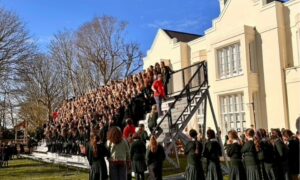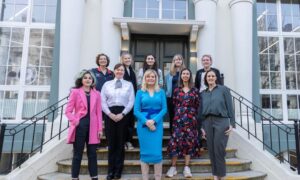“Only connect…” When E. M. Forster wrote these words in his 1910 novel, ‘Howard’s End’, he was expressing his unease at the advent of the technological age. Writing at the turn of the century, Forster foresaw how machines would lead to increased separation; how cars and consumerism would fragment communities – in the name of progress, but at the detriment of human relationships. I wonder how he would feel today? Over a hundred years on, technology reigns supreme; we are constantly contactable, and always connected. Yet with this so-called hyper-connectivity, there is, as Forster predicted, an increasing sense of isolation. Pre-COVID there were real concerns about the link between social media and loneliness – a phenomenon affecting in particular the lives of young people. There is an immediate disconnect when we communicate asynchronously; shielded and emboldened by our screens, uncharacteristic behaviours can emerge – like cyber bullying or trolling; group chats bring friends together but, with this, comes the crippling fear of missing out.
However, have we seen another twist in this tale? Without technology where would we be right now? According to a survey which took place during the first lockdown, 24% of people said they had feelings of loneliness in the “previous two weeks”, compared to 10% before lockdown. While the 10% is still a worryingly high proportion, in a matter of weeks, the effects of the COVID-19 pandemic left millions more people in the UK feeling isolated.
During the pandemic, technology has come to our rescue. When social distancing forced us apart, technology helped us create a web of connectivity, so flexible and adaptable that we have seen magic happen. This week, with various staff members and students self-isolating resulting in a mixed-economy of remote lessons and ‘hybrid’ lessons, I have seen this magic first hand. In a Year 11 virtual PE lesson with Ms Plank, I witnessed a brilliant game of ‘Connect 4’ – learning together, from separate bedrooms, a group discussed, debated, and collaborated. Every week brings a new virtual experience. Thanks to a great team effort, the “all new, same but different Brighton Girls PTFA Christmas Raffle” is going ahead – online, of course (get your tickets here https://brightongirls-ptfa.gdst.net). On Thursday 10th December, members of the Brighton Girls community are invited to a mass virtual cook-along with community chef and local celebrity Momma Cherri and, today, saw a splendid fusion of past and present when I joined the Oasis Group – a group of retired Brighton Girls teachers who still meet regularly. Together, we explored their past experiences of the school through the very modern medium of Zoom.
Yet despite these innovations, E. M. Forster still has a point. Watching a Year 9 Spanish lesson this week (with the teacher at home, half the class in school and half the class at home) gave me an opportunity to compare experiences. Ironically, the topic was mobile phones and connectivity. Everyone was actively learning and contributing, choreographed expertly by Mrs Cormack, who switched seamlessly between a hand waving across the classroom and a virtual hand appearing on screen. But what was lost? The casual, spontaneous interactions, so human, and crucial to the learning process; the sense of being in it together; the whispering of answers to help out a friend; laughter, jokes, and (hooray) a fit of the giggles – above all (as one parent observed in an email this week) the sense of psychological safety that all this brings.
Technology has shown us what is possible. Post-COVID, we must remember this, and take the best of our experience, but then rejoice when we can be fully human again.
“Only connect!”, as Forster wrote, and we will “live in fragments no longer”.


